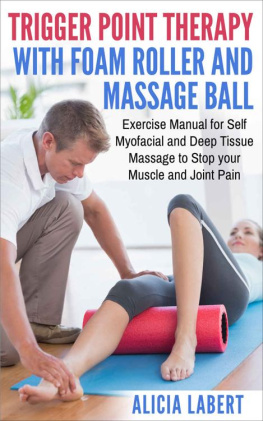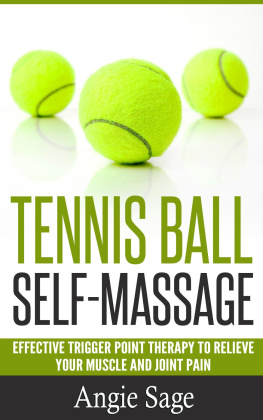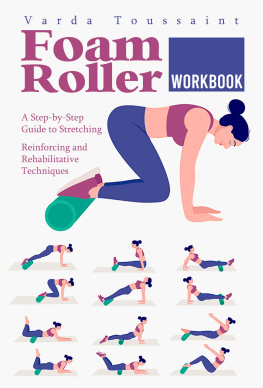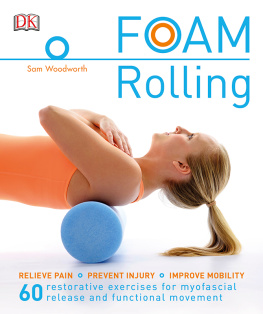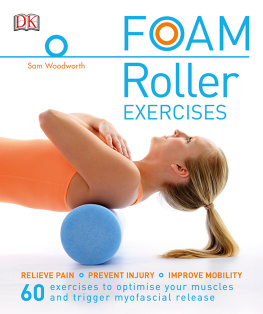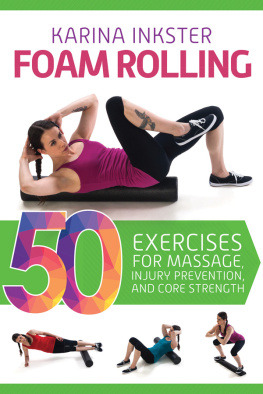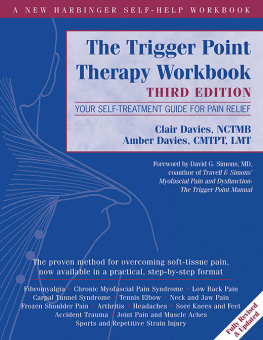Trigger Poin Therapy with Foam Roller and Massage Ball:
Exercise Manual for Self Myofacial and Deep Tissue Massage to Stop Your Muscle and Joint Pain
Text Copyright Alicia Labert
All rights reserved. No part of this guide may be reproduced in any form without permission in writing from the publisher except in the case of brief quotations embodied in critical articles or reviews.
Legal & Disclaimer
The information contained in this book and its contents is not designed to replace or take the place of any form of medical or professional advice; and is not meant to replace the need for independent medical, financial, legal or other professional advice or services, as may be required. The content and information in this book has been provided for educational and entertainment purposes only.
The content and information contained in this book has been compiled from sources deemed reliable, and it is accurate to the best of the Author's knowledge, information and belief. However, the Author cannot guarantee its accuracy and validity and cannot be held liable for any errors and/or omissions. Further, changes are periodically made to this book as and when needed. Where appropriate and/or necessary, you must consult a professional (including but not limited to your doctor, attorney, financial advisor or such other professional advisor) before using any of the suggested remedies, techniques, or information in this book.
Upon using the contents and information contained in this book, you agree to hold harmless the Author from and against any damages, costs, and expenses, including any legal fees potentially resulting from the application of any of the information provided by this book. This disclaimer applies to any loss, damages or injury caused by the use and application, whether directly or indirectly, of any advice or information presented, whether for breach of contract, tort, negligence, personal injury, criminal intent, or under any other cause of action.
You agree to accept all risks of using the information presented inside this book.
You agree that by continuing to read this book, where appropriate and/or necessary, you shall consult a professional (including but not limited to your doctor, attorney, or financial advisor or such other advisor as needed) before using any of the suggested remedies, techniques, or information in this book.
Table of Contents
Introduction
A foam roller is a cylindrical log that is used as workout equipment for its usability and convenience. It was in fact initially used as a tooling aid during physical therapy sessions but has become an important part of a good workout regimen. It is a terrific product for self-massage, core stability, balance training, regular stretching, pain management, yoga exercises and Pilates.
An individual might occasionally suffer from muscle pains because of the tightening up of the tissues. This tightening of the muscle tissue is usually known as muscle knot or simply a trigger point. To ease pains linked to the trigger points, one has to diffuse somehow or break up the knots. The roller is a type of exercise equipment that stretches muscular tissues and tendons plus it breaks down scar tissue formation and soft tissue adhesions. Using your very own body mass on the cylindrical foam, you'll be able to conduct a self-massage, reduce trigger points and ease tight fascia. The pressure of the body on the foam will even enhance blood flow and circulation to your soft tissues. A foam roller is an effective tool that can help in preventing injuries, managing pain, and self-myofascial release. Much like the gymnastic rings, rollers may also be utilized for balance training.
They come in one-foot and three-foot long cylindrical sizes and are also manufactured from top quality hard foam. Whenever getting a foam roller, be sure to check out its feel, firmness, and thickness. There should be no huge holes or perforations as it may cause it to be lumpy, making this useless. You could get a great massage on the IT (iliotibial) band with a foam roller. Just lie on the ground on your side and roll backward and forwards over the roller in between the knee and hip. For the lower leg, move backward and forwards from above the ankle to your knee. Together with IT bands, you can also do massage on your huge muscles in the legs like quads, calves, and hamstring, middle back stretching.
In doing any exercise, ensure that you comply with some specific key points so that it is going to be effective and worthwhile. You need to devote a minimum of one minute rolling forwards and backward on the hurting or tight muscle areas. Refrain from rolling over the bony areas of the body. It is recommended to work with a roller for 5 to 10 minutes just before doing exercises.
The goal is to massage those areas to release pressure and lessen muscle density. Remember, however, that you'll encounter pain while utilizing the roller, primarily on the first few days of usage. As you utilize it often, you are going to work through the tightness and temporary soreness.
Chapter 1: Benefits Of Using Foam Roller
Foam rolling has many more benefits than most people are aware of. It goes way beyond simply soothing tired and sore muscles (though this is one of the major benefits), to so many peripheral health benefits, it might amaze you. In this chapter we will briefly cover some of the benefits you can expect to achieve from a regular foam rolling routine. It is really quite hard (if not impossible) to list all of the benefits you can expect to achieve, as there are quite literally too many benefits to count. Not only are there so many benefits of foam rolling that several books could be written on just the benefits alone, but science and health care professionals are finding new benefits just about every day.
Once youve finished reading this chapter, you will understand why foam rolling is one of the most helpful workouts you can do for your body. You will find that foam rolling is a natural holistic approach to keeping yourself healthy, improving your life drastically, and staving off many effects that come with aging. You will realize that foam rolling may be the most important, life-changing, a decision you have ever made.
- Increased Mobility
One of the effects of aging seems to be a decrease in many people's mobility. That is to say, activities that were once easy and pain-free become more difficult as we age. We may find that simply walking, bending and reaching become strenuous and (for some) even impossible. Many people are convinced this is just a normal process of aging and that there is really nothing we can do about. I have even heard some doctors tell their patients that their decreased mobility is simply them getting older and it is part of life.
Most physical therapists, especially those who specialize in geriatric therapy, will agree that the main cause of limited mobility in the elderly is due to joint inflammation and muscular degradation, as well as gross myofascial adhesions throughout the body. As we will discover in this chapter, one of the main benefits of foam rolling is an increase in the blood flow throughout the body. Much older and older adults may have poor circulation which causes the joints and ligaments to stiffen up, due to improper lubrication and a decreased nutrient-rich blood supply.
The good news is that foam rolling isnt limited to young, healthy, vibrant individuals, but that anyone, from 3 years old (perhaps younger) to 90 years old (perhaps even older) can benefit from foam rolling.
It is especially a very useful addition to any rehabilitation program, in that it can be applied as gently or firmly as necessary, to massage and loosen adhesions and improve circulation throughout the body.
- Pain Therapy
One of the main benefits of foam rolling is in easing the pain in tired and sore muscles, but the pain therapy of foam rolling goes way beyond this. Not only is foam rolling highly beneficial to joint and muscle therapy, but it can also help ease or erase pains that often go untreated for years, or are treated with pain medications that only cover the symptoms and never actually treat them.
Next page
